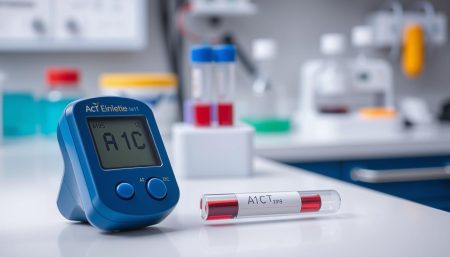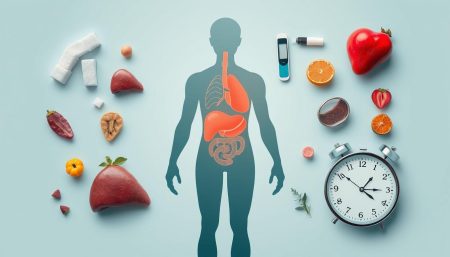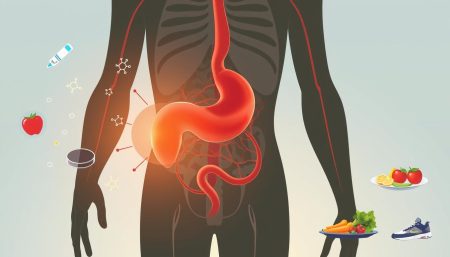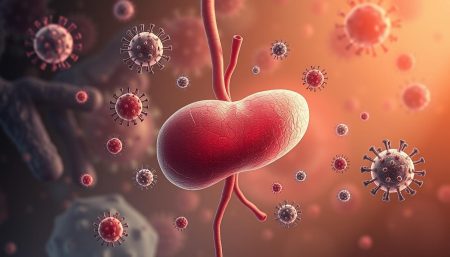It’s important to know the difference between Type1 vs Type2 Diabetes. This knowledge is key for both patients and doctors. As diabetes mellitus types become more common worldwide, understanding diabetes type1 type2 comparison is vital. Knowing the details of these two types helps us improve treatment and lifestyle changes.
This section highlights the main differences between Type1 and Type2 Diabetes Mellitus. We’ll look at how each type affects health. This will help us understand the unique challenges of each form of diabetes. Let’s dive into the world of diabetes mellitus together. We’ll learn how to make better health choices.
Unveiling Diabetes Mellitus: Definitions and Differences
Diabetes Mellitus is a long-term condition where the body can’t use or make insulin right. This affects how glucose moves in the blood. Knowing what is the difference between Type1 and Type2 diabetes mellitus is key for managing and treating it. We’ll look at the unique traits and differences of each type.
Type1 diabetes, also known as juvenile diabetes, is an autoimmune disease. The body’s immune system attacks the cells that make insulin in the pancreas. This type needs lifelong insulin treatment.
Type2 diabetes usually comes from insulin resistance. The body’s cells don’t respond well to insulin, often because of bad lifestyle choices. Understanding understanding diabetes Type1 and Type2 is vital for health.
| Aspect | Type1 Diabetes Mellitus | Type2 Diabetes Mellitus |
|---|---|---|
| Primary Cause | Autoimmune destruction of insulin-producing cells | Insulin resistance combined with insulin deficiency |
| Onset | Typically early in life | Generally in adulthood, but increasingly seen in children |
| Treatment | Insulin injections or pump | Medications, lifestyle changes, and possibly insulin at later stage |
| Prevalence | Less common than Type2 | More common globally |
| Body weight influence at diagnosis | Not typically associated with obesity | Often associated with obesity |
Understanding what is the difference between Type1 and Type2 diabetes mellitus is critical. It helps doctors and patients tailor treatments to each type. This approach improves management and outcomes for patients.
What is the difference between Type1 and Type2 Diabetes Mellitus
It’s important to know the differences between Type1 and Type2 diabetes. Each type affects people in unique ways. We’ll look at the special traits of both types, helping you understand the contrast between them.
Characteristics of Type1 Diabetes Mellitus
Type1 diabetes usually starts in kids and young adults. It’s an autoimmune disease. The immune system attacks and destroys the insulin-making cells in the pancreas. This leads to a lack of insulin, making it hard for the body to control blood sugar levels.
People with Type1 diabetes need insulin their whole lives to manage their blood sugar.
Characteristics of Type2 Diabetes Mellitus
Type2 diabetes mainly affects adults and is often linked to being overweight and unhealthy lifestyle choices. It happens when the body can’t use insulin well or when the pancreas doesn’t make enough insulin. Unlike Type1, Type2 can sometimes be controlled with diet, exercise, and losing weight, along with medication.
| Aspect | Type1 Diabetes | Type2 Diabetes |
|---|---|---|
| Typical Onset | Childhood/Young Adult | Adult |
| Primary Cause | Autoimmune attack on beta cells | Insulin resistance |
| Treatment Required | Lifelong insulin | Varies; diet and lifestyle changes, medications |
| Genetic Factors | Strong | Moderate |
| Role of Lifestyle | Minimal | Significant |
The Origins of Diabetes: Type1 vs Type2 Risk Factors
It’s important to know the risk factors for Type1 and Type2 diabetes. These factors help us understand how each type of diabetes develops. They range from genetics to lifestyle choices.
Genetics are key in both types of diabetes, but they affect each differently. Lifestyle and environment also play a big role in each type’s risk profile.
- Genetic Influences: Family history is a big risk factor for Type2 diabetes.
- Age and Lifestyle: Type2 diabetes often shows up later in life, linked to diet and exercise. Type1, on the other hand, can strike at any age, regardless of lifestyle.
- Autoimmune Factors: Type1 diabetes is caused by an autoimmune attack on insulin-making cells. This is not a factor in Type2 diabetes.
Knowing these differences helps us classify diabetes better. This is key for creating the right prevention and treatment plans for each type. As research grows, we learn more about the risks of type1 vs type2 diabetes. This knowledge helps us improve health care and public health efforts.
Examining Symptoms: How Type1 and Type2 Diabetes Present
In this look at type1 type2 diabetes symptoms comparison, it’s key to see how each type shows itself. Knowing the differences helps in getting the right treatment. Spotting the similarities and differences in symptoms is vital for managing both types.
Early Warning Signs of Type1 Diabetes
- Increased thirst and frequent urination
- Unexplained weight loss
- Fatigue and weakness
- Blurred vision
- High levels of ketones in urine
Identifying Symptoms of Type2 Diabetes
- Frequent infections
- Slow healing of wounds
- Areas of darkened skin, mainly in the neck and armpits
- Increased hunger
- Numbness or tingling in hands or feet
To better understand the type1 type2 diabetes symptoms comparison, the table below shows the main differences and similarities:
| Symptom | Type1 Diabetes | Type2 Diabetes |
|---|---|---|
| Frequent Urination | Common | Common |
| Unexplained Weight Loss | Very Common | Sometimes |
| Fatigue | Common | Common |
| Blurred Vision | Often | Less often |
| Slow Healing | Rare | Common |
Comparative Incidence: Diabetes Type1 vs Type2 Prevalence Rates
It’s key to know the diabetes type1 vs type2 prevalence to tackle the global diabetes issue. Both types of diabetes have different rates of occurrence. This shows how they affect different groups around the world. We’ll look at the incidence rates to show how these conditions vary in different populations.
The term diabetes mellitus types incidence means the number of new cases found in a certain time. It gives a moving picture of how diabetes spreads. This helps doctors and policy makers decide where to put their efforts for prevention and treatment.
| Country | Diabetes Type 1 New Cases (per 100,000) | Diabetes Type 2 New Cases (per 100,000) |
|---|---|---|
| United States | 15 | 450 |
| Canada | 20 | 400 |
| United Kingdom | 17 | 389 |
| Australia | 11 | 300 |
This table shows the big differences in incidence rates of type 1 and type 2 diabetes in some countries. Seeing these rates helps us understand health challenges in different places. It also encourages us to create specific plans to help.
Understanding the Biological Mechanisms of Type1 and Type2 Diabetes
Exploring diabetes type1 type2 biological mechanisms shows how each type is different. Both types affect blood sugar control, but in different ways. This is due to autoimmune diabetes and insulin resistance.
The Autoimmune Aspect of Type1 Diabetes
Type1 diabetes is an autoimmune disease. It happens when the immune system attacks and destroys insulin-making cells in the pancreas. This attack reduces insulin production, which is key for glucose control.
Insulin Resistance and Type2 Diabetes
Type2 diabetes is mainly caused by insulin resistance. This means the body’s cells don’t respond well to insulin. As a result, the pancreas makes more insulin, which can lead to poor glucose control over time.
| Feature | Type1 Diabetes | Type2 Diabetes |
|---|---|---|
| Primary Mechanism | Autoimmune destruction of beta cells | Insulin resistance |
| Insulin Production | Decreased | Initially high, later decreases |
| Onset | Typically early in life | Generally in adulthood |
| Management Focus | Insulin replacement | Enhancing insulin sensitivity |
Management Strategies: Treating Type1 and Type2 Diabetes
Managing type1 type2 diabetes management and treating diabetes mellitus needs quick actions. These actions stop the disease from getting worse and reduce symptoms. Both types of diabetes need a full care plan. This plan helps control blood sugar levels now and keeps them stable in the long run.
- In type1 diabetes, insulin therapy is key, as the body can’t make insulin.
- Type2 diabetes starts with pills to help insulin work better. Sometimes, it needs insulin too.
Checking blood sugar levels often is key for managing both diabetes types. New tech makes tracking easier than before.
Here’s a table showing important management tools for type1 and type2 diabetes. It includes treatments and tech.
| Treatment | Type1 Diabetes | Type2 Diabetes |
|---|---|---|
| Initial Approach | Insulin injections/pumps | Dietary changes, Metformin |
| Monitoring | Continuous glucose monitoring (CGM) | Blood sugar tests, CGM (as needed) |
| Lifestyle Adjustments | Carbohydrate counting, scheduled eating | Weight management, regular exercise |
| Advanced Treatments | Islet cell transplantation | Bariatric surgery (for eligible patients) |
Managing diabetes means picking the right treatment and changing your lifestyle. Each type of diabetes needs its own treatment and monitoring. These must fit the patient’s needs.
Knowing how to manage type1 type2 diabetes management and treating diabetes mellitus is important. It includes learning about patient education and self-care. These help people make smart choices for their health.
Lifestyle and Diet: Mitigating Diabetes Type1 and Type2
Knowing the diabetes lifestyle modifications is key for managing Type1 and Type2 diabetes. The right diet greatly affects your health and diabetes management. This shows the diet impact on diabetes type1 type2.
Eating a balanced diet is essential. It should be low in fat and calories but rich in nutrients. This helps control blood sugar and prevents diabetes complications. Here are some dietary tips:
- High-fiber foods such as vegetables, fruits, whole grains, and legumes
- Lean proteins like chicken, fish, and plant-based proteins
- Healthy fats from nuts, seeds, avocados, and olive oil
- Limited intake of highly processed foods and sugars
Regular exercise is also important. It helps keep your weight healthy and improves insulin sensitivity. Activities like walking, yoga, or more intense workouts are beneficial.
| Meal | Recommendations | Benefits |
|---|---|---|
| Breakfast | High-fiber cereal or oatmeal, low-fat milk, fresh fruits | Stabilizes morning blood sugar levels |
| Lunch | Grilled chicken salad with mixed greens, nuts, and vinaigrette | Provides sustained energy, limits spikes in blood sugar |
| Dinner | Baked salmon, quinoa, steamed vegetables | Ric high-grade. |
| Snacks | Mixed nuts, yogurt, or whole-grain crackers | Balances blood sugar levels between meals |
Getting enough sleep and managing stress are also important. These lifestyle changes can greatly improve your health if you have diabetes.
Diabetes Mellitus Classification: Pathophysiology of Type1 and Type2
The diabetes mellitus classification is key to understanding Type1 and Type2 diabetes. We look into how these diseases affect the body’s normal functions. This knowledge helps us find better ways to treat and manage them.
Pathogenic Process of Type1 Diabetes
Type1 diabetes is caused by an autoimmune attack on the pancreas’ beta cells. These cells make insulin, a hormone that controls blood sugar. Knowing this helps us develop treatments and management plans.
The Pathophysiology Behind Type2 Diabetes
Type2 diabetes comes from insulin resistance and not enough insulin production. It often affects older people, those who are overweight, and those who don’t exercise much. These factors make it harder to manage and prevent.
Here’s a comparison of type1 type2 pathophysiology:
| Aspect | Type1 Diabetes | Type2 Diabetes |
|---|---|---|
| Primary Dysfunction | Autoimmune destruction of beta cells | Insulin resistance and beta cell dysfunction |
| Key Pathophysiological Feature | Complete insulin deficiency | Relative insulin deficiency |
| Risk Factors | Genetic predisposition, environmental factors | Obesity, age, genetic factors |
| Typical Onset | Childhood/Early adolescence | Adults, increasing with age |
Diagnostic Processes for Type1 and Type2 Diabetes Mellitus
Accurate diagnosis of diabetes, whether type 1 or type 2, is key for effective management. Knowing the diabetes mellitus diagnostic criteria helps identify the type. This choice is critical for the right treatment plan.
Diagnosis starts with blood tests that check glucose levels. Here are the main tests for diagnosing diabetes type1 and type2:
- Fasting Plasma Glucose (FPG) Test: This test checks blood sugar after an overnight fast. A level of 126 mg/dL (7.0 mmol/L) or higher on two tests means diabetes.
- A1C Test: This test shows your average blood sugar levels over three months. An A1C level of 6.5% or higher on two tests confirms diabetes.
- Random Plasma Glucose (RPG) Test: This test is done at any time, not tied to when you last ate. A glucose level of 200 mg/dL (11.1 mmol/L) or higher suggests diabetes, with symptoms of high blood sugar.
- Oral Glucose Tolerance Test (OGTT): After a fasting glucose test, you drink a sugar-rich drink. Blood tests then check how well your body handles the sugar. High glucose levels after drinking may show diabetes.
Each test has specific diabetes mellitus diagnostic criteria for diagnosing type1 or type2 diabetes. It’s vital to test for diabetes if symptoms are present. Early diagnosis of diabetes type1 and type2 leads to better management. It also helps prevent or delay severe diabetes complications.
Diabetes Complications: Type1 and Type2 Long-Term Effects
It’s important for patients and doctors to know about diabetes’s long-term effects. Managing diabetes type1 and type2 complications can greatly improve life quality. The journey with diabetes is filled with possible health issues from both types over time.
Long-Term Health Consequences of Type1 Diabetes
People with Type1 diabetes face many complications over time. These problems come from not making insulin, causing high blood sugar. This can harm organs and tissues all over the body.
- Kidney damage (nephropathy)
- Eye damage (retinopathy)
- Nerve damage (neuropathy)
- Heart and blood vessel disease
Understanding Type2 Diabetes Complications
Type2 diabetes is caused by insulin resistance and is often linked to being overweight. It leads to similar long-term problems but in different ways. This is because the body makes insulin but can’t use it well.
Monitoring and treatment adjustments are key in preventing or delaying these complications.
- Increased risk of heart attack or stroke
- Severe nerve damage causing pain, tingling, and mobility issues
- Potential renal failure due to kidney damage
- Progression of retinopathy leading to possible vision loss
For both types of diabetes, keeping blood sugar levels in check and living a healthy lifestyle are key. Understanding and tackling diabetes type1 type2 complications can change lives.
Debunking Myths: Type1 vs Type2 Diabetes Facts and Fallacies
Diabetes is often shrouded in confusion. Today, we aim to clear up common misconceptions about understanding diabetes type1 and type2. This will help improve public knowledge and management strategies.
Type1 and type2 diabetes are often mixed up with false information. Diabetes myths debunked: not all sugars are bad, and eating sweets alone doesn’t cause diabetes. This simplifies the complex genetic and environmental factors involved.
Many think type1 diabetes only affects kids, calling it “juvenile diabetes”. But it can happen at any age. Type2 usually starts in adults, but it’s also seen in younger people now.
- Myth: “People with diabetes cannot eat carbohydrates.”
- Truth: Carbohydrates are important in a healthy diet, even for those with diabetes. Focus on whole, fiber-rich foods.
The link between well-managed diabetesand health, including hair, is key. Keeping blood sugar levels in check helps avoid diabetes complications.
| Myth | Facts |
|---|---|
| Insulin use equates to failed management | Insulin is a vital treatment for many, showing responsible management of the condition. |
| Diabetic individuals cannot live normal lives | With proper management, people with diabetes can live full, active lives. |
Clearing up misconceptions is essential. By debunking these myths, we give patients and the public the facts they need. Understanding diabetes type1 and type2 is more than just correcting errors. It’s about seeing these conditions in a complete and accurate light.
Research and Innovations: The Future of Diabetes Type1 and Type2 Treatment
The world of diabetes treatment is seeing big changes. These changes offer hope for managing both type 1 and type 2 diabetes. Recent diabetes research breakthroughs have improved our understanding. They also speed up the creation of new treatments that could change the game for future of diabetes treatment.
New technologies and medicines are leading the way in diabetes care. Devices that track glucose levels and insulin pumps are getting better. They aim to be more accurate, easy to use, and effective.
- Introduction of Artificial Pancreas Systems
- Advances in Insulin Pump Technology
- Development of Ultra-Fast-Acting Insulin Formulations
- Revolutionary Non-Invasive Blood Glucose Monitoring Techniques
Artificial intelligence is also making a big difference. It helps make diabetes treatment plans that can change as needed. This means care can keep up with how glucose levels change in real-time.
| Technology | Description | Impact on Diabetes Care |
|---|---|---|
| Artificial Pancreas Systems | Closed-loop system providing real-time adjustments of insulin levels. | Improves glycemic control, reducing the risk of hypoglycemia. |
| CGM Devices | Devices that continuously track glucose levels through sensors. | Allows for tighter glucose monitoring and management. |
| AI in Healthcare | AI algorithms predict and manage blood glucose levels. | Enhances personalized care, potentially reducing diabetic complications. |
Gene editing, like CRISPR, is also being explored. It might be able to fix the genetic problems that cause diabetes, mainly in type 1. This could mean preventing diabetes before it starts.
The future of diabetes care looks bright. It will combine technology, new medicines, and better care plans. Thanks to diabetes research breakthroughs, we’re hopeful for treatments that are more tailored, effective, and less invasive.
Type1 and Type2 Diabetes Variations: A Summary of Differences
Exploring diabetes mellitus reveals clear differences between type1 and type2 diabetes. The main differences lie in causes, age of onset, and how to manage them. Type1 diabetes often starts in childhood and is caused by the immune system attacking insulin-making cells.
Type2 diabetes, which usually starts in adulthood, is linked to lifestyle choices. It’s about the body not using insulin well. This leads to high blood sugar levels.
When comparing type1 and type2 diabetes, their treatment plans are different. Type1 diabetes needs insulin all the time because the body can’t make it. Type2 diabetes is managed with diet, exercise, and sometimes medication or insulin.
Both types need careful monitoring to avoid serious problems. This is true for both short-term and long-term health risks.
In conclusion, understanding the differences between type1 and type2 diabetes is key. It shows why each person needs a tailored approach to managing their diabetes. With ongoing research, we hope to find better treatments for both types, improving life for those with diabetes.
FAQ
Q: What is the basic difference between Type1 and Type2 Diabetes Mellitus?
A: Type1 Diabetes is an autoimmune disease. It happens when the body attacks and destroys insulin-making cells in the pancreas. This leads to a lack of insulin.
Type2 Diabetes is different. It’s caused by insulin resistance. This means the body’s cells don’t use insulin well. Over time, the pancreas may also make less insulin.
Q: At what age do people typically develop Type1 or Type2 Diabetes?
A: Type1 Diabetes often starts in children and young adults. But it can happen at any age.
Type2 Diabetes usually starts in adults over 40. But it’s becoming more common in younger adults and even kids because of rising obesity rates.
Q: Are the risk factors for Type1 and Type2 Diabetes the same?
A: No, they’re not the same. Type1 Diabetes risk factors include family history, genetics, and certain viral exposures.
Type2 Diabetes risk factors include obesity, poor diet, lack of exercise, age, and family history.
Q: Can you describe the symptoms of Type1 and Type2 Diabetes?
A: Both types can cause symptoms like excessive thirst, frequent urination, hunger, fatigue, and blurred vision.
Type1 Diabetes symptoms come on suddenly and are severe. Type2 Diabetes symptoms are milder and may not be noticed for years.
Q: How do the prevalences of Type1 and Type2 Diabetes compare?
A: Type2 Diabetes is much more common. It makes up about 90-95% of all diabetes cases.
Type1 Diabetes makes up 5-10%. Both types are increasing, but Type2 is rising faster, tied to obesity rates.
Q: What are the long-term health complications associated with Type1 and Type2 Diabetes?
A: Both types can lead to serious health problems if not managed. These include heart disease, nerve damage, kidney damage, eye damage, and stroke risk.
But Type1 Diabetes complications can happen sooner because it starts earlier in life.
Q: How are Type1 and Type2 Diabetes diagnosed?
A: Diabetes is diagnosed with blood tests that check blood sugar levels. These include fasting blood glucose tests, the A1C test, and glucose tolerance tests.
Autoantibody testing can also help tell Type1 and Type2 Diabetes apart. Certain antibodies are found in Type1 Diabetes.
Q: What management strategies are used for Type1 and Type2 Diabetes?
A: Type1 Diabetes always requires insulin therapy. Type2 Diabetes management can start with diet and lifestyle changes, oral medications, and insulin therapy as needed.
Both types need blood sugar monitoring and heart-healthy lifestyle practices to manage symptoms and prevent complications.
Q: Do lifestyle and diet have differing impacts on Diabetes Type1 and Type2?
A: Diet and lifestyle are key for managing blood sugar in both types. For Type2 Diabetes, weight management, healthy eating, and exercise are essential for prevention and treatment.
While important for Type1 Diabetes too, insulin dosage must be adjusted based on diet and activity levels.
Q: What new research is being conducted on the treatment of Diabetes Type1 and Type2?
A: Research is ongoing in several areas. This includes immunotherapy for Type1 Diabetes, drugs to improve insulin sensitivity and beta-cell function in Type2 Diabetes, artificial pancreas technology, and beta-cell transplantation therapies.


















